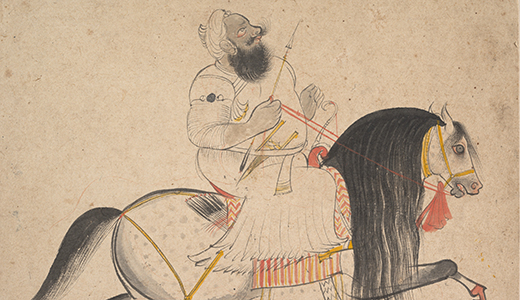 2021
2021
Equestrian portrait of a noble, attributed to Bakhta, c. 1775. The Metropolitan Museum of Art, purchase, Florence and Herbert Irving Gift and Rogers Fund.
Rising cases of Covid-19 in India have brought increased scrutiny to Prime Minister Narendra Modi’s crisis-management skills—and a recent change in his appearance. Several months into the pandemic, Modi debuted a new look: a long white beard had replaced his trim facial hair. The look was quickly assessed alongside the trend of bristled faces among world leaders—dubbed “crisis beards”—although most commentators in India and abroad rejected the idea that the prime minister’s facial hair was a result of lockdown restrictions on barber visits. The essayist Mukul Kesavan suspects that Modi—through his newfound “fleecy magnificence”—hopes to remind devout Hindus of a religious sage. The longer beard coincides with the beginning of construction on a controversial temple in Ayodhya where, in 1992, Hindu nationalists tore down a mosque that dated to the sixteenth century, believing the mosque stood on the birthplace of the god Rama. Kesavan writes in the Telegraph:
Hinduism lacks an organized clergy; it has nothing equivalent to the Buddhist sangha. But men and women dressed in the color of renunciation have always had a certain cachet, never more so than now. Unlike deracinated liberals, Modi sees the power and political potential of this saffron cadre and, as the elevation of [Hindu monk Yogi] Adityanath [to the office of chief minister] illustrates, he has moved to co-opt it. Five years ago, a journalist suggested to me that if Modi ever failed he would be replaced by someone further to the right of him, more bearded, and more visibly Hindu than him…
But Adityanath shouldn’t get his hopes up. If Modi is to be replaced in office, he intends to be replaced by a world-renouncing avatar of himself. During the general elections in 2019, Modi was pictured meditating in a cave in Kedarnath, swathed in saffron. If there was a criticism to be made of the art direction, it was that his hair and beard were too smartly trimmed for the Himalayan ascetic look. That has been remedied now.
 361
361
Coin of Julian II, c. 363. © The J. Paul Getty Museum, gift of Lily Tomlin. Digital image courtesy of the Getty’s Open Content Program.
When Julian assumed the Roman imperial throne in 361, he was at odds with the religious reforms of his predecessors. His uncle Constantine the Great was the first emperor to convert to Christianity. Julian, an enthusiastic Neoplatonist, pledged to rule over his spiritually divided empire as a philosopher. Although Roman rulers tended to be clean-shaven—after the example of Alexander the Great—Julian followed the grooming habits of the Greek philosophers he so admired. His beard—described as “rough and pointed” by the army officer and historian Ammianus Marcellinus—evoked the beards of Plato and Aristotle, the latter believing that semen was the ultimate source of thick hair. In 362 Julian moved to the Syrian city of Antioch (today part of southern Turkey), with a plan to reinstate paganism as the region’s dominant faith. He addressed his Christian critics, who mocked him for thinking a beard could make him a philosopher, in a treatise called the Misopogon, or “Beard Hater”:
Let no one suppose that I am offended by your satire. For I myself furnish you with an excuse for it by wearing my chin as goats do, when I might, I suppose, make it smooth and bare as handsome youths wear theirs, and all women, who are endowed by nature with loveliness. But you, since even in your old age you emulate your own sons and daughters by your soft and delicate way of living, or perhaps by your effeminate dispositions, carefully make your chins smooth, and your manhood you barely reveal and slightly indicate by your foreheads, not by your jaws as I do…No, my temperament does not allow me to look wanton, casting my eyes in all directions in order that in your sight I may appear beautiful, not indeed in soul but in face. For, in your judgment, true beauty of soul consists in a wanton life. I, however, was taught by my tutor to look on the ground when I was on my way to school…It was he who wrought in my soul and as it were carved therein what I did not then desire, though he was very zealous in implanting it…boorishness he called dignity, lack of taste he called sobriety, and not yielding to one’s desires or achieving happiness by that means he called manliness.